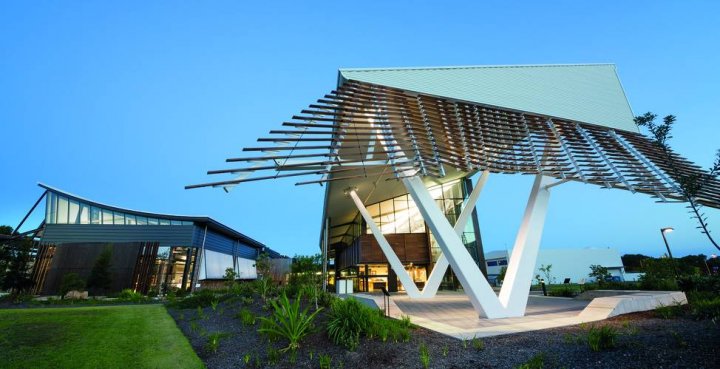
To recognise the cooling benefit of lower solar absorptance roofing, national and state building regulations have long used it as an energy efficiency design parameter. The Volume One and Two roofing and walling material solar absorptance requirements for both NCC 2019 and NCC 2022, and the NSW BASIX roof colour solar absorptance table are outlined in this article.
The 2019 update of the National Construction Code (NCC) brought changes to the Section J Energy Efficiency provisions for Volume One for roofing material solar absorptance requirements and NCC 2022 is introducing new Energy Efficiency requirements for Volume Two. The emphasis of the NCC 2022 Energy Efficiency provisions is on residential buildings and includes an increase in the level of thermal comfort and a whole-of-house energy use budget.
Solar Absorptance
The classification of colours in national and state regulation is based on solar absorptance (SA). SA is the proportion of the total incident solar radiation that is absorbed by the roofing material (the remainder is reflected) and is expressed as a ratio between 0 and 1. A roof with a lower solar absorptance will absorb less heat than a roof with a higher solar absorptance and may help keep the roof space and building cooler on a hot day.1
Solar Absorptance and the National Construction Code (NCC)
NCC 2019 Amendment 1 is still in force under state and territory building regulations until 1 May 2023. The new NCC 2022 energy efficiency requirements are subject to a transition period until 1 October 2023 to assist industry to prepare for the changes.
The Deemed to Satisfy (DTS) pathway of NCC 2022 Volume One and ABCB Housing Provisions utilise roof solar absorptance as an energy efficiency design parameter. NCC 2022 has also introduced wall solar absorptance as an energy efficiency design parameter into the DTS pathway of the ABCB Housing Provisions and for some residential buildings in Volume One (Class 2 sole occupancy units and Class 4 parts of a building).
For detailed information about NCC 2019 and NCC 2022 please refer to the National Construction Code (NCC) website.
Volume One NCC 2019 and NCC 2022
Volume One of NCC 2019 (regulates primarily multi-residential, commercial, industrial and public assembly buildings and some associated structures) requires the solar absorptance (SA) of the upper surface of the roof be ≤ 0.45 to use the Deemed to Satisfy (DTS) compliance pathway. Roof surfaces with SA > 0.45 must use a Performance Solution compliance pathway.2,7
| Solar Absorptance | Compliance Pathway (Volume One NCC 2019 and NCC 2022) |
|---|---|
| ≤ 0.45 | Deemed to Satisfy (or Performance Solution) |
| > 0.45 | Performance Solution |
Note: For NCC 2022, Class 2 sole occupancy units and Class 4 parts of a building have similar DTS roof solar absorptance requirements as housing (Volume 2 – see below) and DTS wall solar absorptance requirements based on Climate Zone and external wall to floor geometry.3,7
Volume Two NCC 2019
Volume Two of NCC 2019 (regulates primarily smaller scale buildings including houses, small sheds, carports and some associated structures), classifies roof colours as Light (L ≤ 0.40), Medium (0.40 < M ≤ 0.60) or Dark (D > 0.60) based on their solar absorptance values. Lower solar absorptance values provide for greater concessions in roof insulation R-value requirements.4,7
| Solar Absorptance | Colour Classification (Volume Two NCC 2019) |
|---|---|
| ≤ 0.40 | Light |
| 0.40 < SA ≤ 0.60 | Medium |
| > 0.60 | Dark |
ABCB Housing Provisions NCC 2022
The ABCB Housing Provisions contain the Deemed to Satisfy (DTS) provisions that meet the requirements for complying with Volume Two of NCC 2022 (regulates primarily smaller scale buildings including houses, small sheds, carports and some associated structures), The DTS provisions utilise both roof and wall solar absorptance values as energy efficiency design parameters following the Elemental and NatHERS compliance pathways.
The minimum insulation requirements under the DTS Elemental compliance pathway vary for roof and wall solar absorptance values with concessions for lower solar absorptance values in warmer climate zones.
In Climate Zones 1 to 5, encompassing northern Australia, Brisbane, Perth and parts of Adelaide and Sydney, the DTS Elemental pathway requires the solar absorptance of the roof to be ≤ 0.64 and the solar absorptance of the wall to be ≤ 0.705,7.
Under a NatHERS compliance pathway, a minimum rating of 7 stars must be achieved. Rating improvements can be achieved in most climate zones by using lower solar absorptance external roof and wall colours.
Roofs with solar absorptance > 0.64 and walls with solar absorptance > 0.70 must use a DTS NatHERS compliance pathway.
| Climate Zone | Solar Absorptance | Deemed to Satisfy Compliance Pathway (ABCB Housing Provisions NCC 2022) |
|---|---|---|
| 1 to 5 | Roof ≤ 0.64 Wall ≤ 0.70 |
Elemental or 7 Star NatHERS |
| 1 to 5 | Roof > 0.64 Wall > 0.70 |
7 Star NatHERS |
| 6 to 8 | Any | Elemental or 7 Star NatHERS |
Colour Classification in Accordance with the New South Wales BASIX
The New South Wales Building and Sustainability Index (BASIX) classifies colours into Light, Medium and Dark based on solar absorptance. The BASIX Thermal Comfort requirement can be met by either a DIY pathway or using a NatHERS pathway. Under the BASIX DIY pathway roof solar absorptance is treated similarly to NCC 2022 Volume 2 housing, requiring ≤ 0.64 in select climate zones. Under the NatHERS pathway, there are no restrictions on solar absorptance of roofing materials.
The BASIX classification is Light (L <0.475), Medium (0.475 ≤ M ≤0.7) and Dark (D >0.7) categories.6,7
| Solar Absorptance | Typical Colour (NSW BASIX) |
|---|---|
| < 0.475 | Light |
| 0.475 - 0.7 | Medium |
| > 0.7 | Dark |
Solar Absorptance values of COLORBOND® steel
BlueScope has provided solar absorptance values for the COLORBOND® steel core colour range. Please refer to COLORBOND® steel colours for a complete list of the values.
Lighter colours typically have lower solar absorptance – there are eleven (11) cool roofing colours in the COLORBOND® steel core colour range featuring low Solar Absorptance (SA) values of less than or equal to 0.45. These colours meet the Deemed-to-Satisfy compliance for roof cladding material in Volume 1 of the NCC 2019 and NCC 2022.
For further information please refer to:
